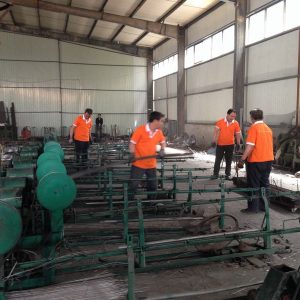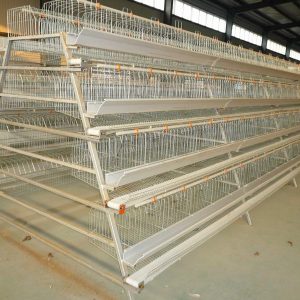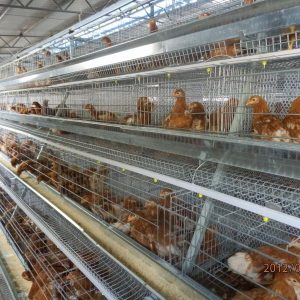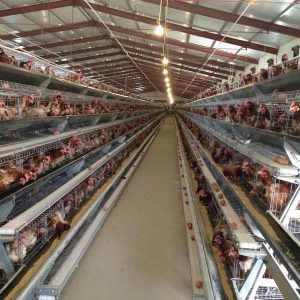
Main points of breeding technology for laying hens
The breeding methods of laying hens are mainly cage and free-range (or free-range). Compared with stocking, the efficiency of cage breeding is higher, such as feed conversion rate, egg production rate, etc. are higher than the stocking method; stocking can improve the quality of eggs, can meet consumer demand for egg quality.
What are the construction requirements for laying hen houses?
The orientation of the enclosed chicken house should be determined according to the local geographic location, climate and environmental conditions, etc., and should meet the requirements of temperature, sunshine and ventilation. The chicken coop in the south should be slightly east facing south, and the north should be slightly west facing south. The distance between the chicken coops is more than 3 times the height of the eaves. Different chicken houses are sorted according to the prevailing local wind direction and resistance. The order of resistance is: brooding room>breeding room>laying house.
The base of the plastic-coated simple chicken house should be strong; the ground should be higher than the outside of the house, moisture-proof, flat, easy to clean and disinfect; the wall should have good thermal insulation performance, can resist the external wind and rain, and the inside of the wall should be covered with cement or white-grey to prevent moisture and facilitate washing ; The roof can be used single or double slope type.
The brooding house requires airtight insulation and ventilation. The lighting equipment should be complete, safe and without leakage. All doors, windows, walls, and ceilings must be free of damage, air, and rain. There are no rat holes in the corners and ground.
The rearing house uses a closed chicken house. Egg laying house can adopt open chicken house and closed chicken house or open and closed chicken house. The length of open chicken coop is 30m~60m, and the length of closed chicken coop is 70m~80m. The width of the chicken coop should be calculated according to the width of the chicken coop and the number of rows of the designed chicken coop. The walkway width is 0.8m~1.2m. Generally, the design of three rows and four walkways is appropriate.
Main points of feeding management before laying
A few weeks before the start of production is the transition period from the growth phase of the hen to the laying period. At this stage, not only a series of work such as transfer to cage, selection and elimination, immunization, feed replacement and increased light, etc., caused great stress to the chicken, but also the physiology of the hen changed drastically, sensitively, and relatively adaptable. Weak, poor disease resistance, if feeding and management is improper, it is easy to affect egg production performance. The feeding management before laying hens should pay attention to the following aspects.
1. Make preparations for transfer to group
Chicken houses and equipment have a greater impact on the health and production of laying hens. The chicken coop and equipment should be repaired before being transferred to the cage, and the feeding system, drinking water system, power supply lighting system, ventilation system, drainage system and cage, cage frame and other equipment should be carefully checked. The house and equipment are fully cleaned and disinfected. The steps are to clean the feces, dust and dirt on the floor, roof and walls of the house, and then rinse the house and equipment with high-pressure water. After drying, spray the disinfectant solution Sterilize, as well as the items used. In addition, we must prepare the necessary utensils, medicines, instruments, record forms and feed, and arrange the feeding personnel.
2. Transfer group to basket
(1) Day-old in cage. Modern high-yielding hybrid egg-laying hens usually see eggs around 17 weeks, so they must be caged before 16-17 weeks of age, so that new hens have a period of time to become familiar with and adapt to the environment before starting production, and form a harmonious group order. Sufficient time for immunization and other work. If the cage is put in too late, the production time will be delayed, which will affect the increase in egg production rate; the hens that have already been laid may be stopped due to strong stress such as relocation, and some chickens may cause yolk peritonitis and increase the number of deaths. . (2) Elimination and elimination. Modern high-yielding hybrid chickens require good growth and development, uniformity and neatness. If uneven, it will seriously affect production performance. When entering the cage, we should remove the undersized, thin chickens and stray chickens with no breeding value according to the requirements of the breed, and select high-quality chickens with lively spirit, strong constitution and suitable weight.
(3) Classified into cages. Even if the rearing management of the brooding period is good, due to factors such as genetics and rearing management, there will still be some smaller and larger chickens in the flock. If they are eliminated, the cost will increase, and the cages in the laying hen house cannot be fully utilized. Therefore, keep the smaller and larger chickens in different cages when they are caged, and take special measures to strengthen management to promote their uniformity. If over-chickens are installed in the middle cage with high temperature and sunny side, appropriate nutrition will be added to promote their growth and development; over-sized chickens should be properly restricted. According to the number of chickens contained in the chicken cage, each single cage can be fed into a sufficient quantity at a time to avoid bullying in the cage first and then chickens in the cage.
3. Immunization
Immunization should be carried out before the start of labor. This immunization is essential to prevent the occurrence of diseases during egg production. The immunization procedure is reasonable and conforms to the actual situation in the field; the vaccine source is reliable, well preserved, and quality assurance; the vaccination route is appropriate, the operation is correct, and the dosage is accurate. After vaccination, check the effect of vaccination, and if necessary, conduct antibody testing to ensure the effect of vaccination, so that the chickens have sufficient antibody levels to prevent disease.
4. Deworming
Deworming work should be done before starting production. For 110-130-day-old chickens, use levamisole 20-40 mg per kilogram of body weight or wormworm 200-300 mg, feed the mixture once a day for 2 days to expel roundworms; use sulfur dichloromethane per kg of body weight Phenol 100-200 mg, mixed with feed, once a day for 2 days to drive the tapeworm; when the coccidia oocysts are seriously contaminated, anticoccidial drugs should be used for 5-6 days after being caged.
5. Light
Light has a great influence on the reproductive function of chickens. Increasing light can stimulate the secretion of sex hormones to promote egg production, and shortening the light will inhibit the secretion of sex hormones, thus inhibiting ovulation and egg production. By controlling the light of laying hens to stimulate and maintain the balance of laying. In addition, the light can adjust the sexual maturity of the reserve chickens and make the hens start production neatly, so the light control before and after production is very critical. The modern high-yielding hybrid strains already have the ability to start production early, and appropriate light stimulation in advance, so that the production time of new hens is properly advanced, is conducive to reducing breeding costs. Flocks that meet the requirements or are slightly larger than the standard weight can increase the light hours to 13 hours at 16 to 17 weeks of age, and then increase by 20 minutes a week until the light hours reach 16 hours, and the flocks with smaller weight Then light stimulation should be started at 18 to 20 weeks of age. The light hours should be gradually increased. If the sudden increase in light is too long, it is easy to cause prolapse of the anus; the light intensity should be appropriate, and it should not be too strong or too weak. If it is too strong, it will easily cause pecking. If it is too weak, it will not stimulate. New hens bred in a sealed house, because the light intensity is too weak during the breeding period, the light intensity before and after the start of production is preferably 10 to 15 lux. New hens bred in the open house are affected by natural light during the breeding period. The front and back light intensity should generally be kept in the range of 15 to 20 lux, otherwise the lighting effect is poor.
6. Feeding
Feeding before the start of production not only affects the increase in egg production rate and the duration of peak egg production, but also affects the death rate.
(1) Change feed in due course. The calcium deposition capacity in the bones is the strongest 2 weeks before the start of production. In order to make hens produce high yields, reduce the breakage rate of eggs, and reduce the occurrence of fatigue in laying hens, the calcium content in the diet should be reduced from 0 to 17 weeks old. 9% increased to 2.5%; when the egg production rate reached 20% to 30%, the diet of laying hens with calcium content of 3.5% was replaced.
(2) Ensure feed intake. Before the start of production, free feeding should be resumed to allow the chickens to be full, ensure balanced nutrition, and promote an increase in egg production.
(3) Ensure drinking water. At the beginning of production, the chicken has a strong metabolism and requires a large amount of water. It is necessary to ensure adequate drinking water. Insufficient drinking water will affect the increase in egg production rate, and there will be more prolapse of the anus.
7. Reduce stress
(1) Arrange working hours reasonably and reduce stress. It is best to arrange the time for group transfer and immunization in the evening, and the movement of catching, transporting and entering the cage should be light. Before feeding into the cage, add material to the feeding chute of the laying hen house, inject water into the sink, and maintain the appropriate light intensity, so that the chicken can drink water and eat the material immediately after entering the cage, and be familiar with the environment as soon as possible. Keep work procedures stable, and there must be a transition period when changing feed.
(2) Use anti-stress additives. There are many stress factors before the start of labor. Anti-stress agents can be added to the feed or drinking water to alleviate the stress. Vitamin C, instant multidimensional, fumaric acid and sedative chlorpromazine are commonly used.
8. health
After being caged, the chicken is unfamiliar with the environment, and a series of management procedures are carried out, which cause greater stress to the chicken. As the egg production rate rises, the chicken’s metabolism is strong, the resistance is poor, and it is very vulnerable to pathogens. Therefore, it must be strengthened. Epidemic prevention and hygiene work. Prevent outsiders from entering the feeding area and chicken coop, and keep them disinfected before entering; keep the chicken coop environment, drinking water and feed sanitation; regularly carry out chicken disinfection and disinfection inside and outside the chicken farm to reduce the incidence of diseases. In addition, pay attention to the use of some antibacterial drugs and Chinese herbal medicine to prevent the occurrence of E. coli and mycoplasmosis.
9. Strengthen observation. Observe the chicken’s feeding, breathing, feces, and egg production rate, and find out if the problem is solved in time. Before and after the production of chickens, the physiological changes are drastic, sensitive and uneasy, and the phenomenon of hanging necks and winging is prone to occur. More patrols should be conducted to detect and deal with them early to reduce deaths. Pay attention to observation, promptly find out anal chickens, anal pecking chickens, bullied chickens and sick and disabled chickens, and pick out and deal with them.
Main points of feeding management during laying hen production
(1) Feeding in stages cannot be ignored
The laying period of commercial laying hens is divided into three stages, and each stage is fed with diets of different nutritional levels to meet their egg laying needs.
Pre-laying period, that is, from the start of production to the peak of egg production (40 weeks old), the egg production rate is more than 80%, (if the rearing period is good, it is generally started at about 20 weeks old, and the eggs are produced at 26-28 weeks old Peak, still more than 80% at 40 weeks of age) During this period, the nutritional content of protein and calcium in the diet should increase as the egg production rate of the flock increases; the crude protein content of the diet of light layer chickens should be 18%, ME2860 Kcal/kg (29~35 degrees when hot should be reduced to 2640; 10~13 degrees increased to 3080 kcal/kg), 3.2% calcium, 3.4% when hot. Each consumes only 105g per day. Ensure that you eat 18.9g of protein (more important than the content index in the feed).
In the mid-lay period, that is, a period after the peak of egg production, the egg production rate is 70% to 80%; (40 to 60 weeks of age) during this period, the nutritional content of protein and calcium in the diet should be dependent on the egg production rate of the flock Change; the crude protein content of the light layer diet should be 16.5%, ME2860 kcal/kg, (same as the previous period), 10% 13% calcium 3.0%, 18% 21% calcium 3.2%, 29% 35% 3.2% calcium, 3.4% calcium at 29~35 degrees. Each day consumes only 104g. Guaranteed to eat 17.2g of protein
In the late laying period, the laying rate is less than 70%. (After 60 weeks of age). During this period, the nutritional content of protein and calcium in the diet should change with the increase and decrease of the egg production rate of the flock; light layer diet: when the temperature is 10~13 degrees, it contains 14% protein, ME3080 kcal/kg, calcium 3.2 %, when the temperature is 18~21 degrees, the crude protein content should be 15%, ME2860 kcal/kg, calcium 3.4%, the temperature 29~35 degrees contains 16% protein, ME2640 kcal/kg calcium 3.7%. Each consumes only 99g per day. Make sure to eat 14.9g of protein.
There are also two feeding methods: pre-laying period (beginning to 42 weeks of age) and late period (after 42 weeks of age).
(2) Do a good job in the control of the first day of birth: the use of the method of fasting during the sexual maturity period has a good effect on postponing the first day of birth of chickens, improving egg production performance, and ensuring high and stable production of chickens. The specific method is: from the chicken egg production rate reached 5%, fasting for 8 to 10 days.
(3) Scientific feeding time and frequency:
In order to maintain a strong appetite for the chickens, there must be a certain amount of time to fix the trough every day, so as to avoid the long-term storage of feed in the trough, which will cause the anorexia and picky eating habits of the chicken.
(4) Drinking water should be timely: the chickens cut off the water for 24 hours, the egg production is reduced by 30%, and it takes 25 to 30 days to return to normal; the chickens cut off the water for 36 hours, the egg production cannot be restored to the original level, and the water cut off for 36 hours Above, some chickens will stop laying eggs, resulting in moulting. Therefore, sufficient drinking water must be supplied in a timely manner.
(5) Feed some health care sand in appropriate amount: Whether it is a breeder or a commercial laying hen, it is necessary to regularly feed grit, especially for caged chickens. The size of the gravel should be moderate, preferably 4-5 mm in diameter. The feeding method is: the flat chickens can be placed in the sand trough, and the caged chickens can be mixed in the feed at a rate of 0.5%.
(6) Laying hens must take good care before and after production, and do a good job of deworming and epidemic prevention: before laying hens laying eggs, all epidemic prevention should be done, otherwise it will not only stress the flock, but also affect the vaccine Play a role. Deworming should be arranged around 110 days of age.
(7) It is very important to rectify the flocks: before the laying hens are put into production, the weak hens should be fed separately to make the hens even and tidy, and take special care of the weak hens. At this time, the beak should be cut off once in time according to the situation.
(8) The inspection of the chicken cage is indispensable: if the laying hen is put into the cage before the production starts, the chicken cage should be carefully checked, and if it is found to be damaged or deformed, it should be repaired in time to prevent the egg from being damaged. According to the actual production, the breakage rate of eggs due to incomplete chicken cages has been very high.
(9) Adjusting the diet is essential: before and after the laying hen is 110 days old, if the growth and development of the laying hen meets the standard, it can be adjusted at an appropriate time. If the feed is changed, the egg production can be directly changed (do not mix the shell powder first). When 5% laying hens lay eggs, they will be fed full-price egg feed to meet the nutritional requirements of laying hens.
(10) Increase the light as soon as possible: As the laying hens begin production, it is necessary to gradually increase the light, and it is appropriate to illuminate for 17 hours at the peak of the laying hens. It is better to fill the light in the morning and evening, and the light should not be reduced at will after the birth.
In addition, the laying hens are very excited and highly neurotic. They should avoid disturbing the laying hens as much as possible and produce stress.
Utilization technology of laying hens in the second stage
The laying rate and egg production of laying hens in the second phase are slightly lower than those in the previous phase. However, it can save a lot of cost and trouble for the purchase of chicks and broods, and the second stage laying hens are more resistant to disease and have a lower mortality rate. The feed is good and the egg ratio is almost less. Comprehensive accounting, the economic benefits are still considerable. The utilization technology of the second laying period of laying hens is now introduced as follows:
1. Forced moulting premature eggs. Forced moulting can lay eggs 3-4 weeks earlier than natural moulting. There are two methods: one is the hunger method: when the egg production rate of the chicken drops to about 30%, stop artificial supplementary light, stop feeding for about 7 days, but do not stop water; each chicken will feed 30 per day for the next 9-10 days -40 grams; then freely feed on layer feed. This method is suitable for grasping 20%-30% of chicken weightlessness. The second is the chemical method: when 20%-30% of the chickens in the flock are depilating, add 2%-3% zinc oxide (3-4.5 g per chicken) to the chicken feed and feed them for 10 consecutive days. Stop the material, keep the water, the light is normal. The above two methods are good for moulting.
2. Increase egg weight and sell more money. The greater the weight of the chicken in the second laying period, the larger the number of eggs laid. Therefore, from the later stage of moulting, it is necessary to seriously strengthen the feeding management, feed nutrient-rich and comprehensive compound feeds, appropriately restrict activities, and promote growth and rejuvenation. It is necessary to approach or exceed the weight before moulting before restoring eggs The large egg laying period lays the foundation.
Hens in the second egg-laying period have slightly higher requirements for the level of fodder than in the first egg-laying period. When the egg production rises, the metabolic energy should not be lower than 12.12-12.55 MJ/kg, and the crude protein is 18%-19%. You can refer to try the following feed formulas: corn 62%, soybean meal 18%, wheat bran 5%, imported fish meal 7%, bone meal 1%, shell meal 7%, salt 0.4%, trace element 0.1%, multi-dimensional element Two in two. The egg laying decline period is delayed 2-3 days after refueling to elimination.



